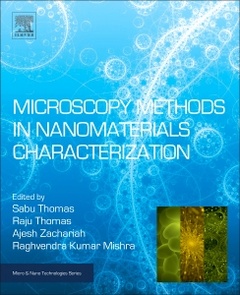Microscopy Methods in Nanomaterials Characterization Micro and Nano Technologies Series
Coordonnateurs : Thomas Sabu, Thomas Raju, Zachariah Ajesh K, Mishra Raghvendra Kumar

Microscopy Methods in Nanomaterials Characterization fills an important gap in the literature with a detailed look at microscopic and X-ray based characterization of nanomaterials. These microscopic techniques are used for the determination of surface morphology and the dispersion characteristics of nanomaterials.
This book deals with the detailed discussion of these aspects, and will provide the reader with a fundamental understanding of morphological tools, such as instrumentation, sample preparation and different kinds of analyses, etc. In addition, it covers the latest developments and trends morphological characterization using a variety of microscopes.
Materials scientists, materials engineers and scientists in related disciplines, including chemistry and physics, will find this to be a detailed, method-orientated guide to microscopy methods of nanocharacterization.
1. Scanning Electron Microscopy, ESEM, and X-Ray Microanalysis 2. Synthesis of Scanning Electron Microscopy Images of Nanostructures by High-Performance Monte Carlo Modeling 3. Scanning electron microscopy under gaseous environment 4. Transmission Electron Microscopy of Nanostructures 5. Plasmonic and Non-Plasmonic Characterization of Nanomaterials 6. Characterization of Materials, Nanomaterials, and Thin-Films by Nanoindentation 7. Super Resolution Optical Microscopy 8. X-ray Microanalysis and Electron Energy Loss Spectroscopy (EELS) 9. Wide Angle X-Ray Diffraction (WXRD) 10. Small Angle Neutron Scattering (SANS) 11. Auger Electron Spectroscopy 12. Energy Dispersive X-ray Spectroscopy Techniques for Nanomaterials
Professor Sabu Thomas is the Director of Centre for Nanoscience and Nanotechnology, Mahatma Gandhi University, Kottayam, Kerala, India. He is also currently the Chairman of the Trivandrum Engineering Science and Technology Research Park (TrESPARK), Trivandrum, Kerala, India. He was the former Vice Chancellor of Mahatma Gandhi University, Kottayam, Kerala, India. Prof. Thomas is a highly committed teacher and a remarkably active researcher well-known nationally and internationally for his outstanding contributions in polymer science and nanotechnology. He has published over 1400 research articles in international refereed journals. and has also edited and written 210 books. His H-index is 140 and total citations are more than 94,000. He has supervised 125 PhD theses. He has received many international and national awards and recognitions. Under the leadership of Prof. Thomas, Mahatma Gandhi University has been transformed into a top University in India.
Prof (Dr). Raju Thomas is currently Vice Chancellor of Middle East University FZE, P.O. BOX 37173, Al Hamara, Ras Al Khaimah, and United Arab Emirates. Dr. Thomas started Professorship from Research and Postgraduate Department of Chemistry, Mar Thoma College, Tiruvalla-3, Kerala, India. Dr. Thomas procured Ph.D degree under the supervision of Prof. (Dr). Sabu Thomas, Director of International and Interuniversity Centre for Nanoscience and Nanotechnology, Mahatma Gandhi University, Kottayam, Kerala, India. He has extensive research experience in Nanoscience and Nanotechnology. He has twelve years of research experience in the Organic Chemistry and Polymer Chemistry laboratories of the School of Chemical Sciences, Mahatma Gandhi University, Kottayam, Kerala, India. He has also worked in the laboratory of Applied Rheology and Polymer processing of Katholieke University, Leuven, Belgium and in the laboratory at Leibniz Institute of Polymer Research Dresden, Germany. He has widely studied the kinetics of
- Takes a method-orientated approach that includes case studies that illustrate how to carry out each characterization technique
- Discusses the advantages and disadvantages of each microscopy characterization technique, giving the reader greater understanding of conditions for different techniques
- Presents an in-depth discussion of each technique, allowing the reader to gain a detailed understanding of each
Date de parution : 05-2017
Ouvrage de 432 p.
19x23.3 cm
Thème de Microscopy Methods in Nanomaterials Characterization :
Mots-clés :
Advantages of X-ray spectroscopy; Advantages; Annular dark-field (ADF)Bright-field (BF)Dark-field (DF)Defects; Applications; Auger electron spectroscopy; Bragg's law; Carbon nanotubes; Characterization of nanomaterials; Characterization; Composites; Computer modeling; Contrast variation; Correlation analysis; Crystalline solids; Dilute solution; Electron diffraction; Electron energy loss spectroscopy; Electron energy-loss spectroscopy (EELS)Energy-dispersive X-ray spectroscopy (EDXS)Energy-filtered TEM (EFTEM)High-resolution electron microscopy (HREM)Lattice imaging; Energy analyzer; Energy dispersive X-ray analysis; ESEM; Experiments; Far-field imaging; Fluorescent molecules; Fractal; Frequency shift; Gaseous; Gel; Glass fibers; Grain boundary segregation; Inlens detectors; Interference; Internal morphology; Lattice parameters; Low vacuum; Mechanical property; Metals; Metamaterial; Microanalysis; Microscopy; Monte Carlo modeling; Nanocomposites; Nanodroplet; Nanoindentation; Nanomaterials; Nanoparticles; Nanophotonics; Nanoscale; Nanostructured materials; Nanostructures imaging; Nanotechnology; Nanowires; Optical characterization; Optimization; Parameters; Plasmonic and nonplasmonic; Polymer; Polymeric materials; Principles; PSF engineering; Quantum wells; Radiationless; Scanning Auger microscopy; Scanning electron microscopy; Scanning TEM (STEM)Thin films; Semiconductors; Semi-dilute solution; Sensitive surface analysis; Signal detectors; Single-molecule localization; Small-angle neutron scattering; Space groups; Subnanometer resolution; Superresolution; Surface-wave imaging; Thin films; Three-dimensional model geometry; Transmission electron microscopy (TEM)VP-SEM; Wavelength dispersive X-ray (WDX)X-ray microanalysis; Wet; Wet-STEM; Wide angle X-ray diffraction; X-ray microanalysis



